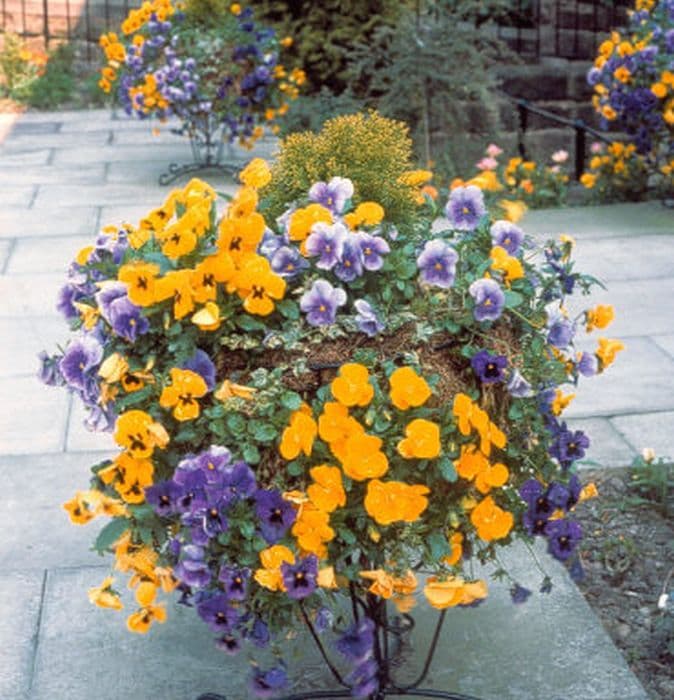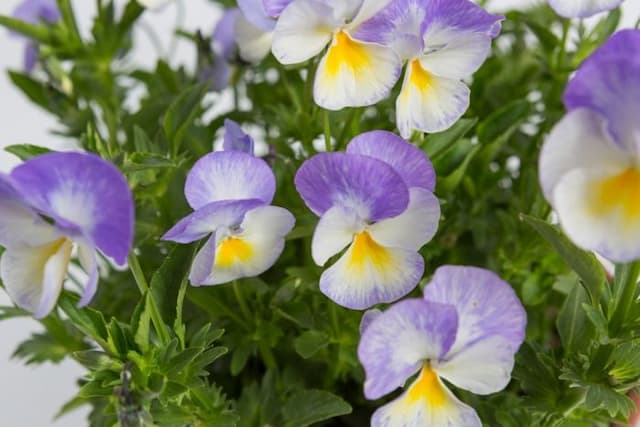Pansy Viola Universal Plus Series

ABOUT
The Viola Universal Plus Series is a collection of plants known for their vibrant and prolific flowers. These plants have a compact, mounded growth habit, which showcases a multitude of blooms that cover the foliage. The flowers are characterized by their velvety texture and consist of five petals. They come in a variety of colors, including purples, blues, yellows, whites, and even bicolored combinations, often with contrasting center markings or whiskers that add to their charm. The leaves are typically of medium green color, heart-shaped, and have a slightly ruffled or scalloped edge. The overall appearance of these plants is lush and rounded, providing a spectacular display of long-lasting color. Flourishing in cooler seasons, the Viola Universal Plus Series is popular among gardeners for adding cheerful hues to landscapes during times when many other plants are not in peak bloom.
About this plant
 Names
NamesFamily
Violaceae
Synonyms
Pansy, Viola
Common names
Viola Universal Plus Series.
 Toxicity
ToxicityTo humans
Pansies, the common name for the Viola Universal Plus Series, are generally considered non-toxic to humans. These plants are often used in culinary applications with the flowers being edible and commonly used as a garnish. However, it is always recommended to eat plants only when you are certain they have not been treated with pesticides or herbicides that could be harmful. Ingesting pansy plants should typically not cause any adverse effects or symptoms of poisoning.
To pets
Pansies, which are the common name for the Viola Universal Plus Series, are generally recognized as non-toxic to pets, including dogs and cats. While they are not poisonous, if a pet were to ingest a large amount of pansies, it may potentially cause mild gastrointestinal upset due to the unusual material in their diet, but toxicity is not expected. Symptoms could include vomiting or diarrhea, but serious consequences are unlikely. As with any plant, monitoring your pet's behavior after ingestion is always sensible, and contact a vet if you have concerns.
 Characteristics
CharacteristicsLife cycle
Biennials
Foliage type
Evergreen
Color of leaves
Green
Flower color
Varies
Height
6-10 inches (15-25 cm)
Spread
6-10 inches (15-25 cm)
Plant type
Herb
Hardiness zones
4-9
Native area
Europe
Benefits
 General Benefits
General Benefits- Continuous Blooming – The Viola Universal Plus Series is known for its ability to produce flowers continuously throughout the growing season, providing long-lasting color in the garden.
- Wide Range of Colors – These violas come in a multitude of colors, offering a rich palette for gardeners to create visually appealing landscapes.
- Cold Tolerance – They have a strong tolerance to colder temperatures, making them suitable for early spring and late fall planting in many climates.
- Ease of Care – Violas are generally easy to maintain, requiring minimal care once established, making them ideal for beginner gardeners or those with limited time.
- Versatility – They can be grown in garden beds, borders, containers, and hanging baskets, providing flexibility in gardening design and space utilization.
- Pollinator-Friendly – The flowers attract butterflies, bees, and other beneficial pollinators, promoting biodiversity within the garden ecosystem.
- Compact Growth – Their compact, mounded growth habit ensures that they work well in both small and large garden spaces without taking over the area.
- Edible Flowers – Viola flowers are edible and can be used to add color and a hint of flavor to salads, desserts, and beverages.
 Medical Properties
Medical Properties- This plant is not used for medical purposes
 Air-purifying Qualities
Air-purifying QualitiesThis plant is not specifically known for air purifying qualities.
 Other Uses
Other Uses- Pansies can be used as a natural dye source for fabric and textiles, providing a range of colors from greens to yellow depending on the mordant used.
- They can be incorporated into frozen ice cubes, adding a decorative floral touch to punch bowls and drinks at special events.
- Pansy flowers can be pressed and included in handcrafted paper, making each sheet unique for special correspondence or artistic purposes.
- The flowers are sometimes used in crafts, such as making homemade soaps, where they add a touch of elegance and natural color.
- In culinary, pansies make elegant garnishes for cakes, pastries, and desserts, adding both color and a subtle flavor.
- They can be included in potpourris, contributing delicate fragrances and colors that enhance the visual appeal and aroma of the mixture.
- Pansies can be used in natural cosmetic preparations, including face creams and toners, for their soothing properties and as a skin softener.
- The blossoms are suitable for making flower confetti, offering a biodegradable option for eco-friendly celebrations.
- They can be used in educational activities, such as teaching children about the lifecycle of plants through garden-based learning.
- Pansy petals can be used in salads to add a splash of color and a mild, slightly sweet flavor, turning an ordinary dish into a gourmet experience.
Interesting Facts
 Feng Shui
Feng ShuiThe plant_name is not used in Feng Shui practice.
 Zodiac Sign Compitability
Zodiac Sign CompitabilityThe plant_name is not used in astrology practice.
 Plant Symbolism
Plant Symbolism- Innocence: Pansies are often associated with the purity and innocence of childhood.
- Remembrance and memory: The pansy's name is derived from the French "pensée," meaning thought or remembrance. In Victorian symbolism, it stood for memories and loving thoughts.
- Love and admiration: Pansies have been symbolic of love and affection. A gift of pansies can mean "I am thinking of you."
- Free-thinking: Sometimes pansies represent free thought or consideration, due to their name being similar to the word "pensive," reflecting thoughtfulness.
 Water
WaterPansies should be watered regularly to maintain moist but not soggy soil. Generally, watering once a week with approximately one gallon per square yard should suffice. However, during particularly hot or dry spells, more frequent watering may be necessary. It's crucial to avoid overhead watering to prevent leaf spot diseases. Always check the top inch of soil for dryness before watering to avoid overwatering, which can lead to root rot.
 Light
LightPansies thrive best in full to partial sun, so positioning them where they will receive at least 6 hours of sunlight per day is ideal. However, in very hot climates, a spot that provides some afternoon shade will help protect them from the intense heat.
 Temperature
TemperaturePansies are cool-weather loving plants, preferring temperatures between 40°F and 60°F. They can survive short periods outside of this range, down to about 20°F and up to 80°F. Keep them away from the harsh winter cold and the summer heat as much as possible.
 Pruning
PruningPansies benefit from deadheading, which involves removing faded or dead flowers to encourage more blooms. Prune these plants early in the morning every few weeks during the flowering season. The best time for pruning is after a flush of blooms begin to fade.
 Cleaning
CleaningAs needed
 Soil
SoilPansies prefer well-draining soil with a pH range of 5.4 to 5.8. Mix peat, vermiculite, and perlite in equal parts to create the best soil mix for these plants, which helps retain moisture yet drains excess water, and is slightly acidic, meeting pansies' needs.
 Repotting
RepottingPansies in the Viola Universal Plus Series should be repotted annually or when they outgrow their current pot. Spring is the best time to repot to minimize stress on the plants.
 Humidity & Misting
Humidity & MistingPansies flourish in moderate humidity levels; it's best to maintain the humidity around 40-60% for optimal growth and flower production.
 Suitable locations
Suitable locationsIndoor
Place in bright, indirect light and maintain cool temperatures for best pansy growth.
Outdoor
Plant in partial shade with well-draining soil; protect from extreme heat.
Hardiness zone
6-10 USDA
 Life cycle
Life cycleThe life cycle of the pansy, part of the Viola Universal Plus Series, begins with seed germination, usually taking place in temperatures between 65-75°F, where the seedlings emerge within 10-14 days. Following germination, the pansy enters the vegetative stage, developing a rosette of leaves and a strong root system; this stage is critical for establishing the plant's foundation. As temperatures cool, the plant transitions to the flowering stage; pansies can bloom in the fall, winter, or spring, depending on regional climate conditions. After pollination, usually facilitated by insects, the pansy produces fruits in the form of capsules that contain numerous seeds. In the final stage, the plant may enter senescence and die back, particularly if exposed to extreme heat or after completing its blooming cycle; however, pansies can sometimes behave as biennials or short-lived perennials. Throughout its life cycle, the pansy may undergo multiple flowering phases, especially when deadheaded regularly and provided with optimal growing conditions.
 Propogation
PropogationPropogation time
Spring to Summer
For the Viola Universal Plus Series, also commonly known as pansies, the most popular method of propagation is through seed. Seed propagation typically takes place in late winter or early spring to allow the pansies to develop before planting out after the last frost. To propagate pansies from seed, start by sowing the tiny seeds onto the surface of a well-draining, moist seed-starting mix, and lightly press them into the soil for good contact. Cover the seed tray with a plastic dome or wrap to retain humidity and place them in a location with bright, indirect light and a temperature of about 65-75 degrees Fahrenheit (18-24 degrees Celsius). Germination typically occurs in 14 to 21 days. Once seedlings develop, thin them out and transplant them into individual pots to grow until they are strong enough to plant outside.








